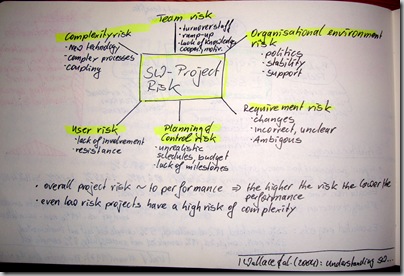Wallace, Linda; Keil, Mark; Rai, Arun: Understanding software project risk – a cluster analysis; in: Information & Management, Vol. 42 (2004), pp. 115–125.
Wallace et al. conducted a survey among 507 software project managers worldwide. They tested a vast set of risks and tried to group these risks into 3 clusters of projects: high, medium, and low risk projects.
The authors assumed 6 dimensions of software project risks –
- Team risk – turnover of staff, ramp-up time; lack of knowledge, cooperation, and motivation
- Organisational environment risk – politics, stability of organisation, management support
- Requirement risk – changes in requirements, incorrect and unclear requirements, and ambiguity
- Planning and control risk – unrealistic budgets, schedules; lack of visible milestones
- User risk – lack of user involvement, resistance by users
- Complexity risk – new technology, automating complex processes, tight coupling
Wallace et al. showed two interesting findings. Firstly, the overall project risk is directly correlated to the project performance – the higher the risk the lower the performance! Secondly, they found that even low risk projects have a high complexity risk.
